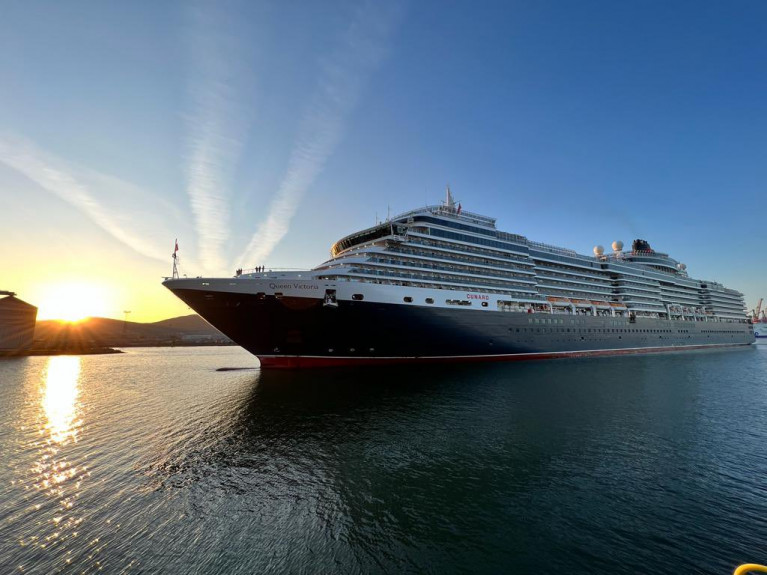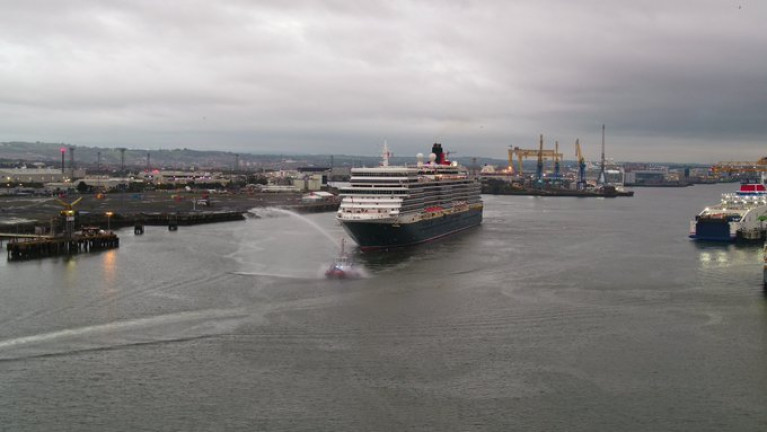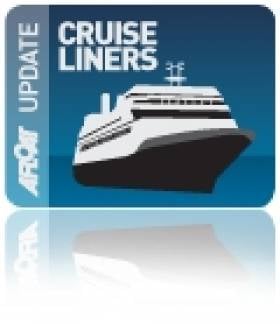Displaying items by tag: Cunarder
The 294m Queen Victoria cruise ship is in Belfast Harbour for dry-docking and is another luxurious vessel turning heads this week.
Putting the sheer scale into context, Queen Victoria as Belfast Telegraph writes, is around 25m longer than the Titanic or the equivalent of 20 buses back to back.
Operated by the Cunard Line, the cruise ship arrived from Tyneside on Tuesday and is capable of carrying more than 2,000 passengers and 980 crew.
Guests can enjoy a spectacular range of entertainment from a full theatre and ballroom to a spa and gym, pool, expanded sun deck and even a winter garden and 6,000 book library.
This time around no tourists are on board as the Queen Victoria is undergoing dry dock operations at Harland & Wolff as Afloat previously reported.
It is now the largest ever cruise ship to have ever dry-docked in a UK shipyard and the only ever Cunard ship to dry-dock in Belfast.
The 270m Aurora from P&O Cruises’ will also arrive in Belfast for dry dock operations.
The 1,000th cruise ship call to Belfast Harbour took place yesterday according to Cruise Belfast, which works in partnership between the port and Visit Belfast.
Cunard Line's MS Queen Elizabeth arrived in Belfast marking a significant milestone for tourism in Northern Ireland, as well as the region’s gradual economic recovery from the pandemic.
Cruise tourism to the city restarted in June this year, with domestic, UK-only cruise itineraries and, to date, the arrival of MS Queen Elizabeth is the 66th cruise call to Belfast this year. The 'Vista' class ship is Cunard's newest luxury ocean liner, which first visited Belfast in 2016 and this will be on a sixth call to Belfast Harbour.
The celebrated arrival of the ‘Berlin’, the first cruise ship to arrive into Belfast in 1996, marked the start of what has been a huge success story for tourism in Northern Ireland, with cruise calls growing year on year, welcoming an incredible 1.7m visitors in the 25 year period.
2019 was a record year for cruise calls, with 146 vessels bringing 285,000 visitors to Northern Ireland, before cruise operations temporarily ceased due to the coronavirus pandemic.
Belfast was named by Cruise Critic as the ‘Best Port of Call’ in the UK and Ireland in 2019 for cruise ships following an investment by the Port to create new quayside facilities and funding from Tourism Northern Ireland for a dedicated cruise Visitor Information Point.
Managed and staffed by Visit Belfast, the terminal uses the latest digital and audio-visual technology to help travel advisors showcase the range of visitor attractions on offer across Belfast and Northern Ireland.
Cruiseship Calls to Dublin Includes Ship-to-Ship Refuelling
Some six hours previously Swan Hellenic's sleek Minerva (1996/12,500grt) picked up a pilot off Dalkey after sailing overnight from Portsmouth. She was followed astern by Saga Cruises Saga Ruby (1973/24,292grt) from Dover and likewise she too picked up a pilot close to the South Burford bouy. Incidentally Minerva had operated for Saga Cruises as their Saga Pearl but in recent years she has returned to her original name.
The classic lines of Saga Ruby are attributed to her combined ocean liner/cruiseship design when launched Vistafjord in 1973. The vessel was built by Swan Hunter Shipbuilders for Norwegian America Line. A decade later she was sold to Cunard Line who retained her original name until 1999 when she became the third Caronia. To read more about this former 'Cunarder' click HERE and how her interior looks now click HERE.
Dawn Princess departed Dublin this mid-afternoon bound for Cobh. Minerva is to due to leave around midnight while Saga Ruby remains overnight, in fact her call is particularly leisurely as she does set sail from the capital until tea-time tomorrow.
- Dublin Port
- Cobh
- Cruise Liners
- bunkers
- dalkey
- Princess Cruises
- Cobh Cruise Terminal
- Cruiseships
- Port of Dublin
- Ports and Shipping News
- Ocean Pier
- Cunard Line
- Cruiseliners
- Saga Cruises
- Saga Ruby
- Caronia
- Cruise Liners news
- Cruise ships
- Swan Hellenic Cruises
- Dawn Princess
- Minerva
- Refueling
- Dublin Cruiseships
- Dublin cruisecalls
- Saga Pearl
- Coastal tanker
- South Burford bouy
- Cunarder


























































